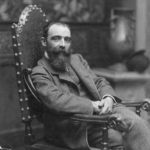Meifrén, Eliseu

Eliseu Meifrén was a landscape and seascape painter who was born in Barcelona in 1859 and who died in 1940 in the same city.
He started his artistic training at the Llotja School of Arts in Barcelona. He was a disciple of Antoni Caba and Ramo Martí Alsina, with whom he began making romàntic style landscapes. In 1878 he travelled to Paris to expand his artistic knowledge and, during his stay, he coincided with the beginning of the impresionist movement, which later influenced his method of painting. One year later, he travelled to Italy, where he met catalan artists like Ramon Tusquets, Arcadi Mas i Fondevila, Enric Serra or Joan Llimona, among others. When he returned to Spain, he won the Gold Medal of the Valencia Regional Exhibition.
In 1883 he returned to Paris. During his stay he illustrated the city's skyline and cafes with drawings and watercolors, which helped him obtain successful recognition from critics and the french públic. At the end of the 80’s he established in Barcelona. He exhibited his artworks at the Barcelona Watercolor Center and he had his first solo exhibition at the Sala Parés, where he exhibited regularly throughout his life. Throughout those years, Meifrén also became part of a modernist group and frequented Els Quatre Gats.
In 1890 he travelled for the third time to the french capital to participate in the Fine Art Salon and also in the Independent Salon of 1892, with Ramon Casas and Santiago Rusiñol, artists with whom he created the group of Sitges one year earlier.
Meifrén exhibited in various exhibitions and competitions and he was awarded various prizes, such as the Silver medal at the Universal of Brussels in 1910, the grand prize at the Universal of Buenos Aires that same year or the medal of honor at the International of San Francisco in 1915, among others.
His first landscapes were characterized with an academic and romantic style, but later they evolved into impressionist works. Meifrén abandoned the romantic preciousness to use a technique of loose brush-strokes and clear palettes, in which its concept of light was similar to the one of Modest Urgell.